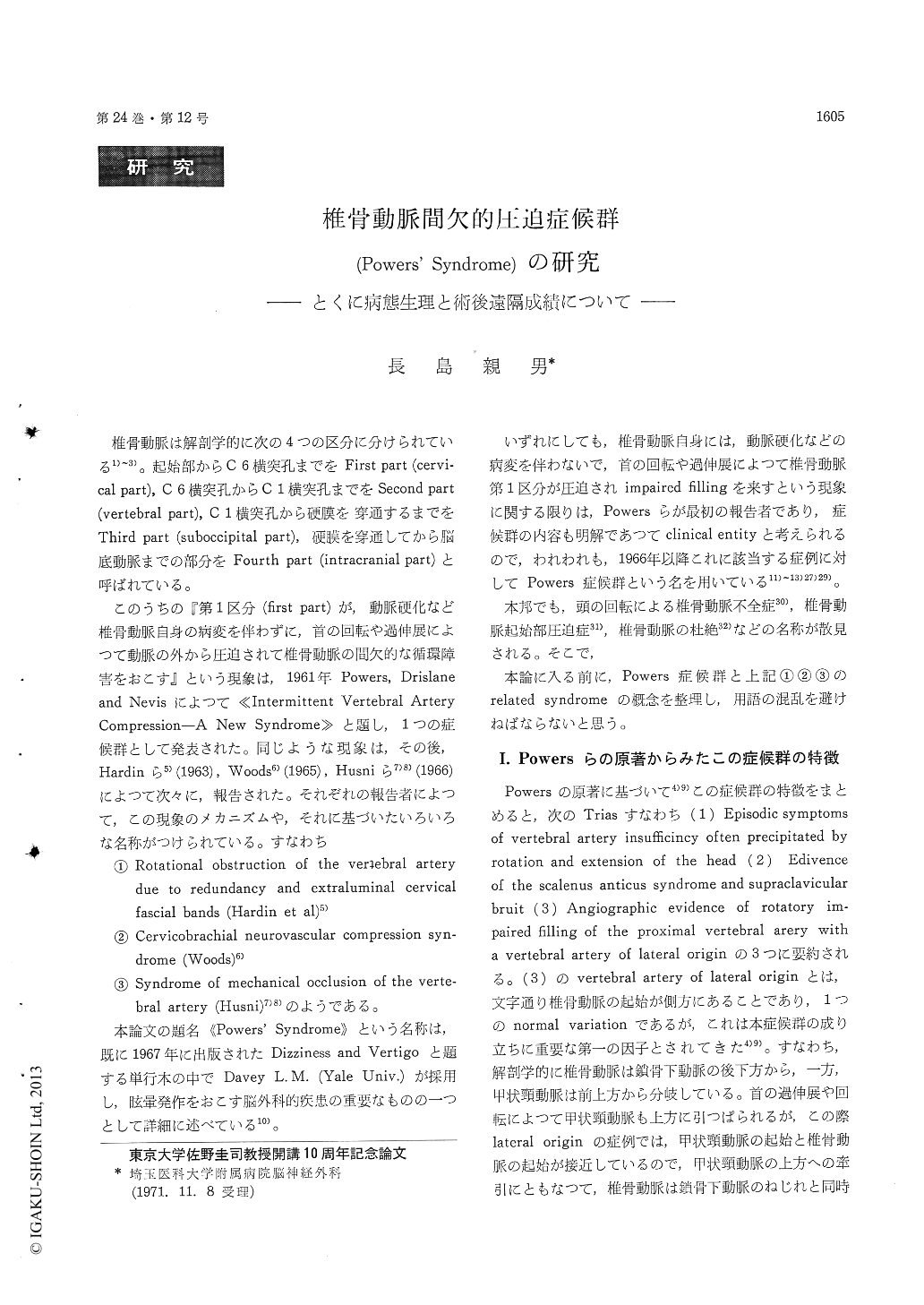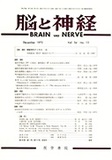Japanese
English
- 有料閲覧
- Abstract 文献概要
- 1ページ目 Look Inside
椎骨動脈は解剖学的に次の4つの区分に分けられている1)〜3)。起始部からC6横突孔までをFirst part(cervical part),C6横突孔からC1横突孔までをSecond part(vertebral part),C1横突孔から硬膜を穿通するまでをThird part(suboccipital part),硬膜を穿通してから脳底動脈までの部分をFourth part(intracranial part)と呼ばれている。
このうちの『第1区分(first part)が,動脈硬化など椎骨動脈自身の病変を伴わずに,首の回転や過伸展によつて動脈の外から圧迫されて椎骨動脈の間欠的な循環障害をおこす』という現象は,1961年Powers,Drislaneand Nevisによつて《Intermittent Vertebral Artery Compression—A New Syndrome》と題し,1つの症候群として発表された。同じような現象は,その後,Hardinら5)(1963),Woods6)(1965),Husniら7)8)(1966)によつて次々に,報告された。それぞれの報告者によつて,この現象のメカニズムや,それに基づいたいろいろな名称がつけられている。
Intermittent vertebral artery compression, described by Powers, Drislane and Nevis, constitues a readily unserstood cause of vertigious attacks and a distinct clinical entity. Sixty seven consecutive cases of the syndrome seen for the last six years were reviewed. There were 46 men and 21 women, ranging in age from 19 to 66 years, most common in the third decade. In all cases, artriography of both the vertebral and carotid arteries was undertaken by the percutaneous transbrachial retrograde technique or infraclavicular subclavian puncture. Six films were taken ; three anteroposterior projection of the neck in hyperextension (one in plain hyperextension, one in hyperextension plus extreme rotation to the right and one in hyperextension plus extreme rotation to the left) ; two projections of the neck in neutral position (one anteroposterior and one lateral) ; and one with a Towne projection to visualize the basilar artery and it's branches. The most common complaint was the episode of vertigo or dizziness ; 47.3% in all cases had severe rotatory vertigo, 29% had impending fainting and 23.7% had sensation of instability. In addition, 5% had drop attack. These episodes were elicited upon turning the head abruptly to look over the shoulder, or looking up at the ceiling or on arising from bed. These episode were rarely an isolated symptom but frequently found in association withnumbness of the affected arm, visual disturbance, nausea and vomiting, but seldom tinnitus or auditory loss (only 13.1%). The Adson scalene tension test was positive in all the patients and rotational supraclavicular bruit in about one half (55.2%). Positional and positioning test of nystagmus (Dix and Hallpike, and Stenger) done in all the patients revealed ether horizontal, vertical, diagonal or combination of those indicating their vestibular disorders are of a central nature. Thus, it is very important to differentiate it from the vertigo due to peripheral disorder of the vestibular end organ such as Meniere's disease and the positional nystagmus of a benign paroximal type. The site of vertebral artery compression was ether at it's origin including subclavian vertebral axis (A type) or between the origin and the sixth cervical vertebra (B type). (Fig. 3-A type ; Fig. 4-B type). Eleven cases had bilateral vertebral artery compression, and 56 cases had unilateral ; 37 cases on the right and 19 cases on the left. The location of origin of the vertebral artery from the subclavian artery was reviewed and was classified into three groups : lateral, medial, and intermediate origin groups. Lateral origin was only noted in 18 out of 48 right-sided vertebral artery compression and in 8 out of 30 left-sided compression which constitues 33.3% (26/78). Although Powers et al noted 17 lateral origin in 28 cases (60.7%) and suggested the lateral origin of the vertebral artery can be ascribed to produce kinking or angulation of proximal vertebral artery. Our data suggested that it can not be simply explained by his "lateral origin theory" only. We therefore examined a level of the arch of the subclavian artery. The higher arch (more than 10 mm above the clavicle) andmoderately high arch (between 9 to 5 mm above the clavicle) are noted in 53.5 and 21.4 percent respectively ; 74.9 percent showed elevated subclavian arch above the clavicle. With higher arch of the subclavian artery well up into the soft part of the neck and above the clavicle, it runs greater risk from trauma, to form hypertrophy in the scalene anticus muscle and thickened deep cervical fascia and to result in a redundant vertebral artery which is liable to be obstructed by neck rotation or extension.
Surgery, consisting of three main steps ; scalenotomy, ligation and division of the thyrocervical trunck and periarterial stripping of proximal vertebral artery with microsurgical technique was performed in 38 cases on the right side, in 25 cases on the left side, and 4 cases on both side with time interval more than one month between the one side procedure and the other. Follow-up longest 6 years was obtained by questinonnaire or reexamination. The results (Table 2) indicate that excellent relief can be obtained after surgical treatment. (Excellent 84%, Good 12%, Same 4%, Worse 0)
Finally, the literatures on the intermittent vertebral artery compression and it's related syndromes have been reviewed. These include (1) the syndrodme of mechanical occlusion of the vertebral artery-Husni, (2) cervico-branchial neurovascular compression syndrome-Woods, (3) rotational obstruction of the vertebral artery due to redunduncy and (4) extraluminal cervical fascial bands-Hardin. The various mechanismus that lead to the development of symptoms have been discussed.

Copyright © 1972, Igaku-Shoin Ltd. All rights reserved.


